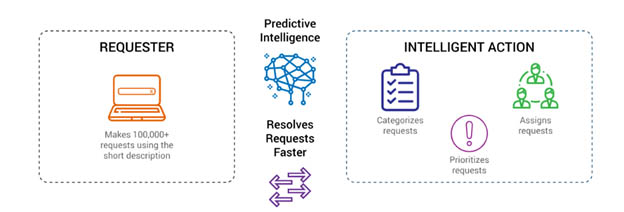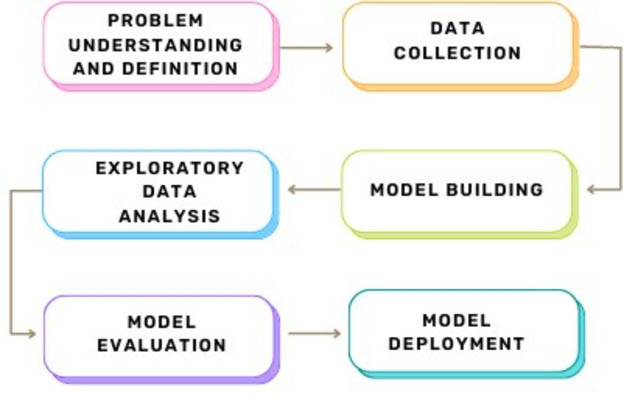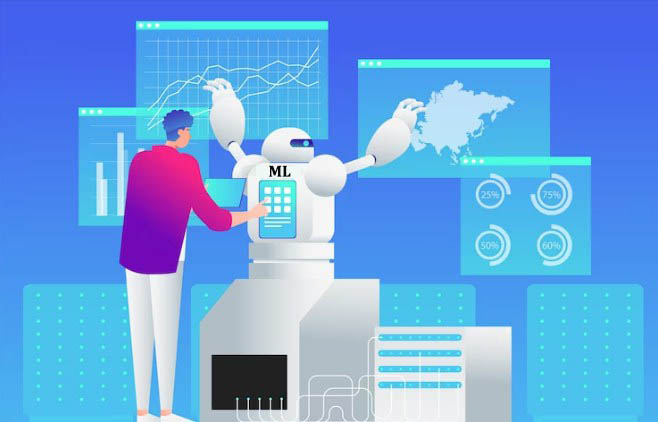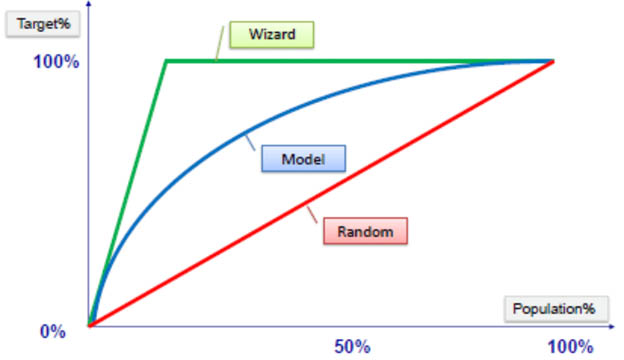Overview of ServiceNow Predictive Intelligence
In today’s world, where data is key, predicting problems before they happen is super important. That’s why ServiceNow, a top digital platform, has come up with smart predictive tools.
With ServiceNow’s predictive tools, using fancy math and smart data tricks, businesses can make better choices, run smoother, and stay ahead of the game.
Join us as we examine the Developer’s Guide to ServiceNow Predictive Intelligence.

Implementing Predictive Intelligence Step-by-Step

Are they wondering How do you use predictive intelligence in ServiceNow? Let’s explore step by step.
1. Define Your Use Case and Goals
The first step is identifying a business problem or opportunity where predictive intelligence could provide value.
Some common use cases were covered earlier like incident management, HR analytics, and demand forecasting. But you’ll want to zero in on the precise pain points or objectives for your organization.
2. Gather and Prepare Data
With your use case defined, the next step is making sure you have the right data to train predictive models.
This data could come from multiple sources like ServiceNow tables, external databases, cloud apps, or data streams. Identify all relevant data sources. If needed, consult with ServiceNow Support Service Providers to ensure proper data integration and accessibility across systems.
3. Choose and Configure Machine Learning Models
Based on your use case goals and the structure of your data, you’ll select the appropriate machine-learning techniques and algorithms.
ServiceNow Development Services provides a range of options like regression, decision trees, neural nets, and more.
Don’t worry if you’re not a machine learning expert – ServiceNow Developer’s Guide to ServiceNow Predictive Intelligence guides you through this process with best practice recommendations.
You’ll configure model parameters like training data size, performance evaluation metrics, and validation methods.
4. Train, Evaluate, and Refine Models
With your models configured, you can initiate the training process right from the ServiceNow interface.
The models will run through multiple iterations, automatically optimizing algorithm settings and hyperparameters.
Closely monitor model performance metrics like accuracy, precision, and recall.
If results don’t meet your targets, you may need to go back and refine the training data, algorithms, or model configurations.
This iterative process continues until you achieve satisfactory model evaluations.
5. Deploy and Integrate Models
Once you have a winning predictive model, it’s time to deploy it into production workflows and applications.
ServiceNow makes this relatively straightforward with built-in deployment management capabilities.
You’ll establish performance monitoring processes to track the model’s accuracy as it makes live predictions on new data.
Drift detection helps identify when the model may need to be retrained on refreshed data to maintain predictive power.
You can automate integration so the model’s predictive outputs trigger actions like updating records, generating alerts, or kicking off workflows.
This seamless interoperability amplifies predictive intelligence’s impact.
Embracing How you use predictive intelligence in ServiceNow is key to staying ahead in today’s competitive landscape.
Building and Training Machine Learning Models

ServiceNow has an established multi-stage process for developing predictive models using machine learning:
- Data Preparation
- Model Selection
- Training
- Evaluation
Want to know how easy it is to get started with Predictive Intelligence in ServiceNow? Let’s find out!
Data preparation is crucial, as data quality directly impacts the predictive power.
This stage involves preprocessing to handle issues like missing values, outliers, and formatting inconsistencies. ServiceNow Consulting Solutions offer data-wrangling tools and expert guidance to streamline this process.
With data ready, you’ll select the appropriate machine-learning approach based on your use case and data structure.
Options include regression techniques, decision trees, neural networks, and ensemble methods that combine multiple models.
Simply configure training parameters like data sizes and performance targets, and let ServiceNow’s automation handle the iterative training process.
The models will cycle through running algorithms on your data, automatically tuning settings to optimize for predictive accuracy.
As models get trained, closely monitor performance metrics like precision, recall, and overall predictive scores.
If results don’t meet targets, loop back and tweak training inputs, algorithms, or configurations.
Keep iterating until evaluations give you a high-performing, production-ready model.
Deploying and Monitoring Predictive Models

Are you excited to get started with Predictive Intelligence in ServiceNow?
With a battle-tested predictive model, you’re ready to integrate it into live workflows – and ServiceNow makes this relatively straightforward.
Using ServiceNow’s built-in model deployment and management tools, you can monitor models over time to track predictive performance on a continuous stream of new data inputs.
If model accuracy starts dropping due to data drift or other issues, you can retrain on updated datasets.
Let us explore Predictive Intelligence in ServiceNow and how it can revolutionize your workflows.
The real power comes from triggering actions based on model predictions – automatically updating records, generating alerts, or kicking off entire workflow streams.
This seamless integration allows predictive intelligence to directly drive operational decision-making and processes.
You’ll establish performance monitoring processes from the start, with dashboards highlighting key metrics like accuracy, false positive rates, and throughput over time.
Automated drift tracking helps surface when models may need retraining to maintain predictive power as underlying data shifts.
Following DevOps best practices like comprehensive testing in staging environments is critical before going live.
You’ll also implement version control and portability to simplify deploying model updates.
Curious about what lies beyond? Explore Predictive Intelligence in ServiceNow and discover endless possibilities.
Use Cases and Examples
Developers, are you eager to get started with Predictive Intelligence in ServiceNow?
Predictive intelligence has countless applications across business functions and industries. A few key use case examples:
IT Operations & Incident Management
- Predict potential service outages based on system logs and incident data
- Detect anomalies in infrastructure performance metrics or user activity
- Prioritize incoming incidents based on predicted severity and impact
Human Resources
- Identify risks for employee attrition based on factors like job satisfaction
- Optimize talent acquisition by predicting top candidates and job fit
- Forecast future headcount needs based on historical hiring trends
Customer Service
- Predict the likelihood of customer churn by analyzing product usage
- Improve case routing and timeframes through better complexity prediction
- Automate sentiment analysis and prioritize high-risk customer interactions
Advanced Topics and Future Trends

Developers, it’s time to roll up your sleeves and Explore Predictive Intelligence in ServiceNow like never before.
Explainable AI
As predictive models grow more sophisticated, “explainable AI” techniques aim to provide transparency into the machine learning “black box.”
Being able to interpret predictive model decisions builds trust and accountability.
External AI/ML Integration
While ServiceNow’s native predictive intelligence is powerful, integrating with external AI/ML platforms unlocks additional possibilities.
Options to leverage specialized models or bleeding-edge techniques are not available in ServiceNow itself.
Responsible AI
With predictive models impacting business decisions, ethical considerations take center stage.
Priorities include mitigating bias, respecting data privacy, and aligning predictive outputs with defined risk thresholds or policies.
Continuous Intelligence
The future vision goes beyond just predictive to continuous intelligence, with models automatically learning and updating themselves based on streaming data inputs and reinforcement loops – true autonomous adaptation.
Discovering how you use predictive intelligence in ServiceNow opens up new opportunities for innovation and growth.
Team Roles and Collaboration
While developers are at the forefront of implementing ServiceNow predictive intelligence, it’s a team effort involving multiple roles:
- Data Scientists/Analysts: These are the subject matter experts who understand business problems, monitor data sources, and work closely with developers to prepare datasets and evaluate model performance. Strong communication between developers and data experts is key.
- Functional SMEs: For use cases like IT operations, HR, customer service, etc., you’ll need close involvement from functional leads.
They provide context around processes, goals, and data to properly frame predictive intelligence solutions.
- DevOps Engineers: As predictive models get deployed into production, DevOps practices like monitoring, automated testing, and CI/CD pipelines become critical.
DevOps engineers implement processes for release management and model updates.
- Data Engineers: Especially for more complex use cases integrating multiple data sources, data engineers can assist in properly structuring data pipelines and optimizing data flows into ServiceNow.
- Business Stakeholders: Executive sponsors, department heads, and process owners are essential for ensuring predictive intelligence aligns with overarching business strategies and objectives. They help prioritize use cases and measure ROI.
While developers may take a central role, a cross-functional team with clear responsibilities enables faster implementation cycles and better predictive intelligence adoption.
Data Security and Governance

With predictive models being trained on large datasets, often containing sensitive information, data security, and governance are paramount concerns:
Data Security Best Practices:
- Follow least-privilege principles, only providing model access to essential data
- Leverage ServiceNow’s role-based access controls and data encryption
- Implement robust authentication and authorization processes
- Maintain audit trails of all data accessed for model training
- Securely integrate with external data sources using approved methods
Data Governance Framework:
ServiceNow enables organizations to establish data governance policies and controls around predictive intelligence initiatives:
- Create a predictive analytics council with stakeholders from IT, security, analytics, and business teams
- Define processes for data inventory, classification, and approval workflows
- Establish monitoring and reporting processes to ensure policy adherence
- Implement guidelines around data retention, archiving, and disposal
Ethical AI Principles
In addition, teams should embrace ethical AI principles as they develop and operationalize predictive models:
- Ensure models are transparent and their decision process can be explained
- Mitigate bias by carefully evaluating training data and model outputs
- Respect data privacy by adhering to compliance standards like GDPR
- Continuously monitor models for unintended consequences or demographic skews
- Develop human operator instructions for applying predictions appropriately
By prioritizing data security and governance upfront, ServiceNow customers can reap the frameworks for predictive intelligence while properly managing risks.
Tips to Improve Predictive Model Performance

Image Source – https://dimensionless.in/
Retraining Models
To keep your predictive models working well, they often need to be updated with fresh data regularly.
ServiceNow makes it easier to retrain models by automating many of the manual steps involved.
You can set up automated processes that trigger model retraining based on specific conditions, like a certain level of data drift or a drop in predictive accuracy.
This ensures your models stay current and keep giving accurate predictions.
Continuous Progress
Apart from checking how your predictive models are doing, ServiceNow also encourages a culture of ongoing improvement by providing ways to collect feedback and make changes to models based on real results.
Boosting Model Precision
Focusing on data refinement and feature optimization is key to elevating the precision of predictive models.
Ensuring that the data used for training is accurate, pertinent, and recent can notably amplify the model’s predictive prowess.
Additionally, carefully selecting the most pertinent features while eliminating redundant or extraneous ones can streamline the model’s performance and enhance its efficiency.
Conclusion
ServiceNow’s predictive intelligence represents a game-changing opportunity for developers to infuse applications and processes with intelligent, data-driven predictive power.
Looking ahead, innovations in areas like explainable AI, ethical AI practices, and continuous learning models will continue driving predictive intelligence’s evolution from a powerful tool to an autonomous capability.
Ultimately, embracing ServiceNow Predictive Intelligence opens up new frontiers of proactive, predictive applications and data-driven decision-making for your organization.
When exploring predictive intelligence in ServiceNow, developers often ask, What are the frameworks for predictive intelligence?
Don’t miss out on the opportunity to pioneer these new intelligent experiences.
What areas of your business operations could most benefit from predictive intelligence capabilities? Share your thoughts on potential use cases you’re interested in exploring.
FAQs
1) What data is needed to train predictive models in ServiceNow?
Predictive intelligence can use structured data like incident logs and unstructured data like customer emails. More relevant, high-quality data leads to better predictive models.
2) How does ServiceNow ensure predictive model accuracy?
Techniques like cross-validation and holdout testing evaluate model performance. Ongoing monitoring and retraining with new data also maintain accuracy over time.
3) Can ServiceNow integrate with other AI/ML platforms?
Yes, ServiceNow allows integrating external AI/ML platforms to access specialized models and techniques beyond its built-in capabilities.
4) What is predictive intelligence for problem management ServiceNow?
Predictive intelligence for problem management ServiceNow refers to the use of advanced analytics and machine learning techniques to anticipate and prevent IT issues before they occur.



